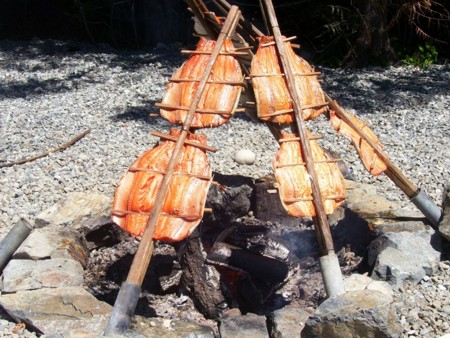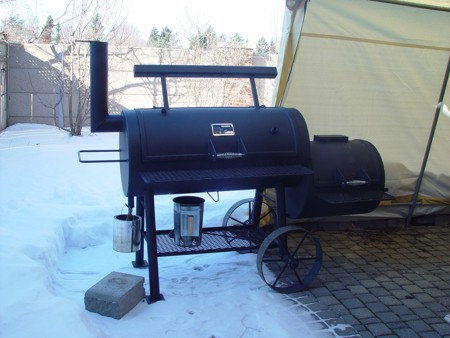Celebrate smoking!
No, not the disgusting hand-to-mouth habit that involves tobacco or other questionable substances, but the unique ages-old process of cooking, flavouring and preserving food via exposure to low, slow, smoky fire!
 Replica of an ancient B.C. native open pit salmon-smoking set-up.
Replica of an ancient B.C. native open pit salmon-smoking set-up.
They’ve been doing it this way on the Pacific Coast for at least 5,000 years.
It works just fine, but we have more efficient and more sanitary options today.
If you thought smoking was just for the pros, well… You’re partly right. Doing it right, on a medium or large scale, involves a significant financial investment and no small investment in your time, learning the ins and outs.
 Maggie J’s Yoder Wichita Competition Smoker. Quarter-inch steel plate
Maggie J’s Yoder Wichita Competition Smoker. Quarter-inch steel plate
and tube construction throughout. Dual damper heat/smoke control,
dual thermometers on the 42 in. x 20 in. cooking chamber. And, yes,
we do use it year-round, even in the depths of Canadian Winter!
At Maggie J’s, we have a medium-sized wood-fired smoker/grill (above). We do all our smoked meats and sausages on it. You can hot-smoke four or five pork shoulders, or three good-sized briskets on this baby at one time. That’s on the main grill. The upper shelf will hold two dozen sausages or three full racks of ribs.
Now, with all that said, there are lots of bigger smokers out there. Many are built into their own trailers. Others are so large that you can walk right into them. Think of a two-car garage filled with meat!
Choosing your fuel
Your choice of fuel will determine your choice of equipment to a certain extent. Consider your options carefully before laying down your hard-earned bucks!
Wood billets (or, chunks) is the preferred fuel for many pro/competition smoke practitioners. Some actually burn cord wood from the tree of their choice in their very-large smokers. Every smoke-chef has hie or her own favourite wood. Some have different favourites to complement the flavours of different foods. We’ll get to that a little later. Just remember, wherever you get your wood, make sure it is thoroughly dry and always use hardwood.
Wood Pellets are commonly used in “automatic” wood-fired heating stoves. They can also be used for smoking foods. But these pellets of compressed sawdust and wood waste are considered decidedly inferior to real hardwood by serious smokers. they are typically made from a mixture of woods, not pure hardwood. One advantage pellets offer is that you can fill up the feed hopper of a pellet smoker with fuel and set the automatic stoker to deliver pellets to the firebox at whatever rate you wish. Then, you can just go to bed and let the smoker do its thing, on autopilot, overnight.
Charcoal is a classic BBQ fuel, but it’s far from optimal for smoking. It doesn’t burn that long and its smoke dissipates very quickly, once the white ash appears. Charcoal is, however, a convenient way to start your smoker. A small bed of charcoal coals is perfect for getting hardwood billets or cord wood going. Yes, you can smoke on a charcoal grill. Just wait until the hardwood is smoking real good, and the cooking chamber temperature is where you want it before placing food on the grill.
Propane gas or Natural gas are the fuels of choice for most family BBQ grillers. Most of those grills are self-starting, now, and you can control the heat precisely with the turn of a dial. They’re pretty useless for smoking by themselves, though. If you already have, and love, a gas grill, though, you can easily get smoking by purchasing a “smoke box” at almost any BBQ centre or hardware store. These are typically steel boxes that fit on your grill and have one hinged and perforated side. You place hardwood chips in the box and the gas flame heats them to smouldering.
Electricity is a minority fuel among home grillers and “serious” smokers. But it is a definite player in the small commercial smoker market. An electric smoker uses a heating element similar to an electric charcoal BBQ startrer to heat hardwood chips to smouldering. A typical commercial steel-cabinet electric smoker looks a bit like a wall oven, can sit on a restaurant kitchen counter or worktable, and requires minimal tending and minimal maintenance (just a few wood chip ashes to clean out). It also requires minimal ventilation, which can usually be accomplished by a regular restaurant range hood exhaust system.
Equipment variations and adaptations
As I mentioned briefly above, you can adapt charcoal or gas grills to smoker duty. But a dedicated smoker is always superior if you are going to be a frequent or large-volume smoker.
Some grills are purpose-built to use a variety of combustible solids. The recently-famous “Big Green Egg” is a great example of a multi-fuel, multi-role grill.
On the other hand… I’ve seen more than one “smokehouse” made from the shell of an old fridge. Granted, these were almost all set up for “cold smoking”, rather than low-and-slow cooking. Think Jerky, and smoke-dried meats (i.e.- Smoked Salmon), in general. Jerry-rigged cold-smokers can be as simple as a wooden box with a hose attached to channel smoke from a charcoal or wood-fired grill/burner to the food compartment. The set-up provides smoke without appreciable heat.
I think we’ve all seen, at one time or another, a grill/smoker made from an old steel oil drum. Recycling old oil or solvent drums is not a safe thing to do. Even if you get it “clean”, there might still be enough volatile material inside to cause a fire or explosion. Even cooking oils, common food additives and other seemingly innocuous substances can be deadly. I refer you to the case of a teenaged student at a high school in south Ottawa who was killed when the steel drum he was torching into a BBQ/smoker as a school project exploded in the school metal shop. The drum originally carried vegetable oil and, yes, it was squeaky clean. But vapours from a volatile solvent used to clean it remained inside. Eric Leighton was just 18.
Next time…
In Part II of our exploration of smoking, we’ll cover wood chips for flavouring, some must-have accessories, and some must-know cooling tips.
~ Maggie J.


Nice job on presenting a great resource for us all to read.
This information is very useful, thanks for the research that you have done.
Your method of describing everything in this paragraph
is actually fastidious, every one can simply understand it, Thanks a lot.